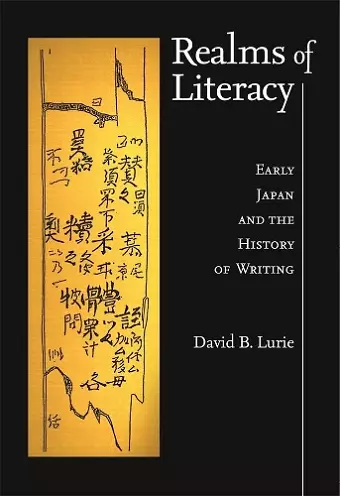Realms of Literacy
Early Japan and the History of Writing
Format:Hardback
Publisher:Harvard University, Asia Center
Published:14th Dec '11
Currently unavailable, and unfortunately no date known when it will be back

In the world history of writing, Japan presents an unusually detailed record of transition to literacy. Extant materials attest to the social, cultural, and political contexts and consequences of the advent of writing and reading, from the earliest appearance of imported artifacts with Chinese inscriptions in the first century BCE, through the production of texts within the Japanese archipelago in the fifth century, to the widespread literacies and the simultaneous rise of a full-fledged state in the late seventh and eighth centuries.
David B. Lurie explores the complex processes of adaptation and invention that defined the early Japanese transition from orality to textuality. Drawing on archaeological and archival sources varying in content, style, and medium, this book highlights the diverse modes and uses of writing that coexisted in a variety of configurations among different social groups. It offers new perspectives on the pragmatic contexts and varied natures of multiple simultaneous literacies, the relations between languages and systems of inscription, and the aesthetic dimensions of writing. Lurie’s investigation into the textual practices of early Japan illuminates not only the cultural history of East Asia but also the broader comparative history of writing and literacy in the ancient world.
This fascinating, erudite book considers the nature of literacy and the relationship between written and spoken language while exploding myths and fallacies about the development of writing in ancient Japan. In painstaking detail (and lucid prose), Lurie explores a wide range of complex developments as Korean scribes and then the Japanese themselves adapted the Chinese writing system to fulfill a variety of orthographic needs, especially during the mid- to late seventh century. From talismanic signs to baggage tags, from doodling to diplomatic messages, from reference works and record keeping to poetry and politically motivated official histories, the author examines a vast amount of material, analyzing the ways logography and phonography were deployed to varying effects. He shows how the flexibility of the common practice of kundoku (reading by gloss)—i.e., reading Chinese scripts using Japanese pronunciation and grammar—was exploited to create the different styles used in writing the Kojiki and the Nihon shoki histories and the Man 'yoshu, a poetry anthology, each of which is itself a mixture of styles. -- M. H. Childs * Choice *
- Nominated for John Whitney Hall Book Prize 2013
ISBN: 9780674060654
Dimensions: 229mm x 152mm x 38mm
Weight: 907g
524 pages